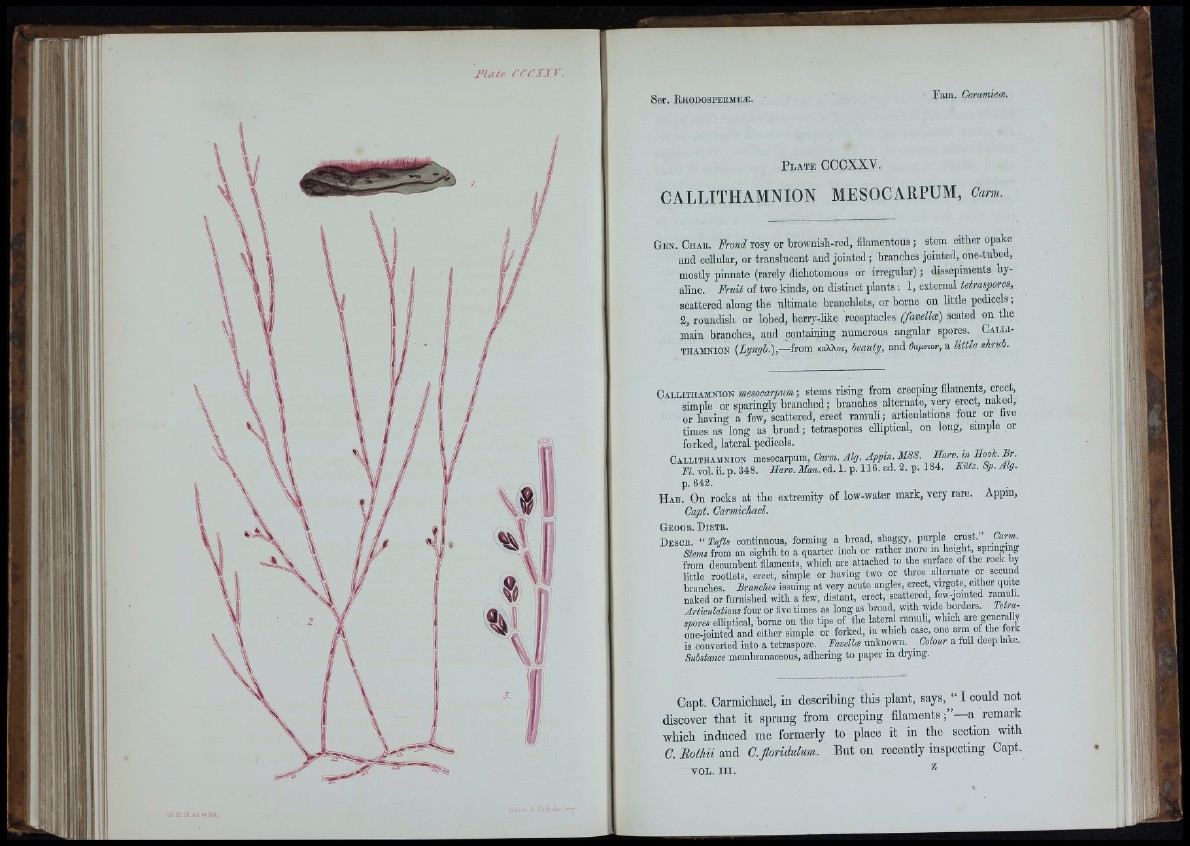
l U J e C C C X X V .
J tti
P l a t e CCCXXV.
CALLITHAMNION MLSOCARPUM, Carm.
G e n . C h a e . Frond rosy or brownish-red, filamentous ; stem either opake
and ceUular, or translucent and jo in ted ; branches jo in te d , one-tubed,
mostly pinnate (rarely dichotomous or irregular) ; dissepiments h y aline.
F ru it of two kinds, on distinct plants : 1, external tetraspores,
scattered along the ultimate branchlets, or borne on little pedicels ;
2, roundish or lobed, berry-like receptacles (favelloe) seated on the
main branches, and containing numerous angular spores. C a l l i t
h a m n io n [Lyngb.),—from mWos, beauty, and Bafxmov, a little shrub.
Callithamnion mesocarpum; stems rising from creeping filaments, erect,
simple or sparingly b ranched; branches alternate, very erect, naked,
nakea,
or having 1 • a I*__few, scattered, erect ramuli •; a articulations vl.ipn 1 fiI.Tn*ns TOUT*four 01*or I1V0
live
times as long as b ro ad ; tetraspores elliptical, on long, simple or
forked, lateral pedicels.
Callithamnion mesocarpum, Carm. Alg. Appin. MSS. Harv.m Sooh.Br.
i ’i. vol. ii. p. 348. 1. p. 1 1 6 . ed. 2. p. 184. Kutz. Sp.Alg.
p . 6 4 2 .
H a b . On rocks at th e extremity of low-water mark, very rare. Appin,
Capt. Carmichael.
Geogb. D is t b .
D e scb. “ Tufts continuous, forming a broad, shaggy, purple crust, Carm.
S tem from an eighth to a quarter inch or rather inore in height, spnnging
from decumbent filaments, which are attached to the surface of the rock by
little rootlets, erect, simple or haviug two or three alternate or secund
branches. Branches issuing at very acute angles, erect, ra-gate, either quite
naked or furnished with a few. distant, erect, scattered, few-jointed rmuuh.
AHiculations four or five times as long as broad, with wide borders. Tetraspores
elliptical, borne on the tips of the lateral ramuh, which are generaUy
one-joiuted and either simple or forked, in which case one a™ of the fork
is converted into a tetraspore. lavelke unknown. Colour a fuU deep lake.
' ■ ; membranaceous, adhering to paper in drying.
Capt. Carmichael, in describing this plant, says,^“ I could not
discover that it sprang from creeping f i l ame n t s a remark
which induced me formerly to place it in the section with
C. Bothii and C.floridulum. But on recently inspecting Capt.
VOL. I I I . ^